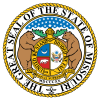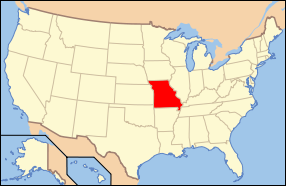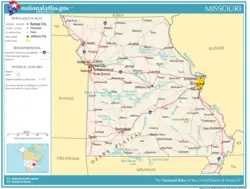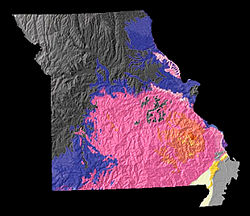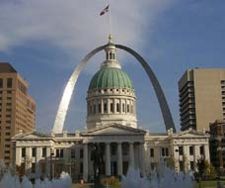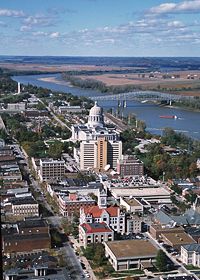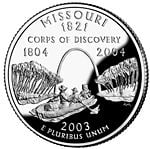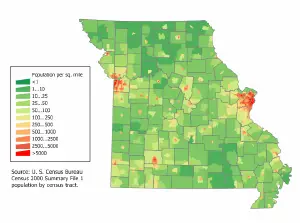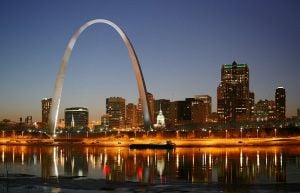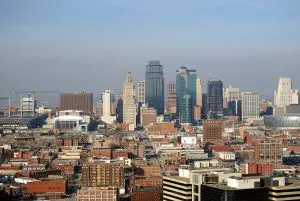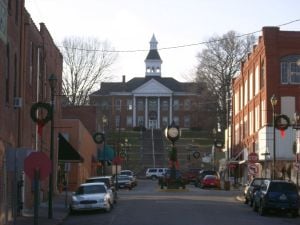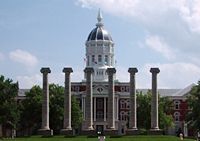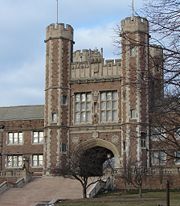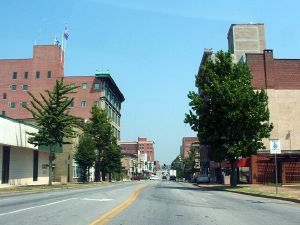Missouri
| State of Missouri | |||||||||||
| |||||||||||
| Official language(s) | None | ||||||||||
| Capital | Jefferson City | ||||||||||
| Largest city | Kansas City | ||||||||||
| Largest metro area | Greater St Louis Area[1] | ||||||||||
| Area | Ranked 21st | ||||||||||
| - Total | 69,704 sq mi (180,533 km²) | ||||||||||
| - Width | 240 miles (385 km) | ||||||||||
| - Length | 300 miles (480 km) | ||||||||||
| - % water | 1.17 | ||||||||||
| - Latitude | 36° N to 40° 37′ N | ||||||||||
| - Longitude | 89° 6′ W to 95° 46′ W | ||||||||||
| Population | Ranked 18th in the U.S. | ||||||||||
| - Total | 6,010,688 (2011 est)[2] | ||||||||||
| - Density | 87.3/sq mi (33.7/km2) Ranked 28th in the U.S. | ||||||||||
| - Median income | $46,867 (35th) | ||||||||||
| Elevation | |||||||||||
| - Highest point | Taum Sauk Mountain[3][4] 1,772 ft (540 m) | ||||||||||
| - Mean | 800 ft (240 m) | ||||||||||
| - Lowest point | Saint Francis River at southern Arkansas border[3][4] 230 ft (70 m) | ||||||||||
| Admission to Union | August 10, 1821 (24th) | ||||||||||
| Governor | Jay Nixon (D) | ||||||||||
| Lieutenant Governor | Peter Kinder (R) | ||||||||||
| U.S. Senators | Claire McCaskill (D) Roy Blunt (R) | ||||||||||
| Time zone | Central: UTC-6/-5 | ||||||||||
| Abbreviations | MO US-MO | ||||||||||
| Web site | www.mo.gov | ||||||||||
Missouri is a state in the Midwestern region of the United States. It was acquired from France as part of the Louisiana Purchase in 1803 and was admitted into the Union as the 24th state in 1821.
Once a battleground between slave owners and abolitionists, Missouri today mirrors the demographic, economic, and political makeup of the nation, with a mixture of urban and rural culture, and has long been considered a political bellwether state. It has both Midwestern and Southern cultural influences.
Missouri also marks a transition between the eastern and western United States, with St. Louis often called the "western-most eastern city" and Kansas City the "eastern-most western city." There is great diversity in Missourians' culture and character. The two largest metropolitan areas are centers of fine art, music, and theater, in marked contrast to the folk culture and native crafts of the Ozarks. Despite these differences, Missourians can generally be described as politically, socially, and religiously conservative.
More than 47 percent of Missouri is situated on the the Ozarks Plateau. It is a region of clear-water lakes, mountain streams and rivers, towering bluffs, underground caverns, and abundant wildlife that has managed largely to avoid development.
Etymology and pronunciation
The state is named after the Missouri River, which in turn is named after the Siouan Indian tribe whose Illinois name, ouemessourita (wimihsoorita[5]), means "those who have dugout canoes".[6]
The pronunciation of the final syllable of "Missouri" is a matter of controversy, with significant numbers insisting on a relatively tense vowel (as in "meet") or lax ("mitt" or "mutt"). From a linguistic point of view, there is no correct pronunciation, but rather, there are simply patterns of variation.
Geography
Missouri's geography is highly varied. The northern part of the state lies in dissected till plains (formed from the soil and rocks left by melting glaciers and cut by rivers and streams), while the southern part lies in the Ozark Mountains, with the Missouri River dividing the two. The confluence of the Mississippi and Missouri rivers is located near the city of St. Louis.
Missouri borders eight different states. It is bounded on the north by Iowa; on the east, across the Mississippi River, by Illinois, Kentucky, and Tennessee; on the south by Arkansas; and on the west by Oklahoma, Kansas, and Nebraska (the last across the Missouri River.) The sections of the state which touch Kentucky, Tennessee and Nebraska, however, are only a matter of miles. The two largest rivers in the state are the Mississippi, which defines the eastern boundary of the state, and the Missouri, which flows from west to east through the state, practically connecting the two largest cities, Kansas City and St. Louis. The capital is Jefferson City, located in the center of the state.
Although today the state is usually considered part of the Midwest,[7] historically Missouri was sometimes considered a Southern state,[8] chiefly because of the settlement of migrants from the South and its status as a slave state before the Civil War. The counties that made up "Little Dixie" were those along the Missouri River in the center of the state, settled by southern migrants who held the greatest concentration of slaves.
Residents of cities farther north and of the state's large metropolitan areas, including those where most of the state's population resides (Kansas City, St. Louis, and Columbia), typically consider themselves Midwestern. In rural areas and cities farther south, such as Cape Girardeau, Poplar Bluff, Springfield, and Sikeston, residents typically self-identify as more Southern.
Topography
North of the Missouri River lie the Northern Plains that stretch into Iowa, Nebraska, and Kansas. Here, gentle rolling hills remain behind from the glaciation that once extended from the north to the Missouri River. Missouri has many large river bluffs along the Mississippi, Missouri, and Meramec Rivers.
Southern Missouri rises to the Ozark Mountains, a dissected plateau surrounding the Precambrian igneous St. Francois Mountains. The Ozark plateau begins around Springfield and extends into northwestern Arkansas, southeastern Kansas, and northeastern Oklahoma. Springfield in southwestern Missouri lies on the most northwestern part of the Ozark plateau.
The southeastern part of the state, known as the Bootheel because of its shape, is part of the Mississippi Alluvial Plain. This region is the lowest, flattest, and wettest part of the state, as well as among the poorest, as the economy is mostly agricultural. It is also the most fertile, with cotton and rice crops predominant.
The Bootheel was the epicenter of the New Madrid earthquakes of 1811–1812. Scientists estimate there is a seven to ten percent chance, by the mid-twenty-first century, of a repeat of a major earthquake like those of 1811-1812, which likely had magnitudes of between 7.5 and 8.0. There is a 25 to 40 percent chance, in a 50-year time span, of a magnitude 6.0 or greater earthquake.
Missouri has over 6,000 recorded caves (second only to Kentucky). Perry County has both the largest number of caves and the single longest cave in the state (Crevice Cave, at 28.2 miles).[9]
Flora and fauna
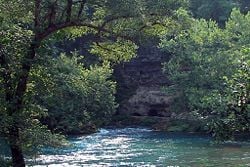
Forests cover about one-third of Missouri, mostly found in the Ozarks and along rivers, but the old-growth trees were cut down by settlers and loggers. Some small stands of the original tallgrass prairie that once covered the state still exist.
The mammals found in Missouri include black bears, bobcats, coyotes, otters, deer, and beaver. The birds include eagles, quail, wild turkeys, grouse, American woodcocks, ducks, geese, and other waterbirds. Such fish as bass, bluegill, paddlefish, and catfish are found in its rivers.
Climate
Missouri generally has a humid continental climate, with cold winters and hot and humid summers. In the southern part of the state, particularly in the Bootheel, the climate borders on a humid subtropical climate. Located in the interior United States, Missouri often experiences extremes in temperatures. Without high mountains or oceans nearby to moderate temperature, its climate is alternately influenced by air from the cold Arctic and the hot and humid Gulf of Mexico.
History
| Missouri State symbols |
|
Prehistory
People first arrived in the area now known as Missouri about 12,000 B.C.E. and lived by hunting mammoths, mastodons, and giant bison. Around 7000 B.C.E. the Archaic culture developed. When the Woodland culture arrived about 3000 years ago, the nomadic lifestyle of the previous peoples changed into a more settled one in which crops were grown. As communities grew larger, some of them built flat-topped mounds that were probably used for ceremonies and burials. Among the tribes that came to live in Missouri were the Chickasaw and Mississippian in the southeast; the Oto, Missouri, and Ioway in the north; and the Osage in the south.
Early history
Spanish explorer Hernando de Soto crossed into Missouri on his journey through the Southeast in search of gold, becoming the first European to see the state. Not until 1673 did other Europeans arrive, the Frenchmen Father Jacques Marquette and Louis Jolliet. In 1682, another French explorer, René-Robert Cavelier, Sieur de La Salle, traveled the length of the Mississippi River and claimed the land alongside it for France. He gave the region the name Louisiana in honor of Louis XIV. Fur trappers and missionaries followed, and lead began to be mined in 1715 with African slaves. The town of Ste. Genevieve was the first permanent settlement, the second being the fur-trading post called Saint Louis, established in 1763.
In 1762, aware that it was losing the French and Indian War, France ceded its holdings west of the Mississippi to Spain to keep them out of British hands. After the American Revolutionary War, American settlers began to filter into the Spanish-held territory in search of land. In the early 1800s, Spain signed the territory back over to the French, who sold it to the new United States. President Thomas Jefferson asked Meriwether Lewis to explore this new acquisition. The Lewis and Clark Expedition left from St. Louis in 1804, following the Missouri River west, returning two years later.
The state was the epicenter of the New Madrid earthquakes in 1811-1812, possibly the most massive earthquakes in the United States since the founding of the country. Casualties were light due to the sparse population.
Statehood
Missouri was admitted as a slave state in 1821 as part of the Missouri Compromise, which was intended to keep the number of slave and free states equal. St. Louis and later the cities of Independence, Kansas City, and St. Joseph in the western part of the state, served as departure points for settlers heading to the West. River traffic and trade along the Mississippi was integral to the state's economy.
In 1835 the Platte Purchase was added to the northwest corner of the state after the land was purchased from the native tribes, making the Missouri River the border north of the Kansas River. This addition made what was already the largest state in the Union at the time (about 66,500 square miles (172,000 km²) to Virginia's 65,000 square miles (which included West Virginia at the time) even larger.[10]
Conflict over slavery
As many of the early settlers in western Missouri migrated from the Upper South, they brought along enslaved African Americans and a desire to continue their culture and the institution of slavery. They settled predominantly along the Missouri River, in an area of flatlands that enabled plantation agriculture and became known as "Little Dixie." In the early 1830s, Mormon migrants from northern states and Canada began settling near Independence and areas just north of there. Conflicts over slavery and religion arose between the "old settlers" (mainly from the South) and the Mormons openly practicing polygamy (mainly from the North and Canada). The Mormon War erupted, and by 1839 the settlers had expelled the Mormons from Missouri.
Conflicts over slavery exacerbated border tensions among the states and territories. In 1838-1839 a border dispute with Iowa resulted in both states' calling up militias along the border. After many incidents with Kansans crossing the western border for attacks (including setting a fire in the historic Westport area of Kansas City), a border war erupted between Missouri and Kansas. The controversial issue of the status of slavery in Kansas would have an impact on the make-up of the entire nation. In response, both eastern Kansas and western Missouri were flooded with three distinct groups from around the nation: pro-slavers, free-staters and abolitionists, all coming to cast their vote for or against slavery. Violence broke out among these rival groups, with kidnapping and tar–and–feathering eventually turning to raids and massacres along both sides of the border. These skirmished, which lasted from roughly 1854 to 1858, came to be called "The Border Wars," or "Bleeding Kansas."
From the 1830s to the 1860s, Missouri's population almost doubled with every decade. Most of the newcomers were Americans, but many Irish and German immigrants arrived in the late 1840s and 1850s. Having fled famine, oppression, and revolutionary upheaval, they were not sympathetic to slavery.
Most Missouri farmers practiced subsistence farming. The majority of those who held slaves had fewer than five each. The tensions over slavery had chiefly to do with the future of the state and nation. In 1860 enslaved African Americans made up less than ten percent of the state's population of 1,182,012.[11]
After the secession of Southern states began, the Missouri legislature called for the election of a special convention on secession. The convention voted decisively to remain within the Union. Despite the presence of strong pro-Southern elements in the state, Union forces succeeded in installing a pro-Union provisional government that was immediately recognized by Washington, D.C., as the legal government. This decision provided both pro-Union militia forces for service within the state and volunteer regiments for the Union Army.
After winning victories at the battle of Wilson's Creek and the siege of Lexington and suffering losses elsewhere, the state's Confederate forces had little choice but to retreat to Arkansas and later Texas. Though regular Confederate troops staged some large-scale raids into Missouri, the fighting in the state for the next three years consisted chiefly of guerrilla warfare—quick, small-unit tactics. Such insurgencies also arose in other portions of the Confederacy occupied during the Civil War.
Modern times
After the Civil War, Missouri population and economy grew rapidly, boosted by the railroads and by bridges connecting Missouri with Kansas and Illinois. Cattlemen in the West could bring their cattle to Kansas City, which became the center of a meatpacking industry. World War I brought a demand for mules and lead from Missouri. During World War II, more than 300,000 troops trained at Fort Leonard Wood.
During the mid-1950s and 1960s, St. Louis suffered from deindustrialization and loss of jobs in railroads and manufacturing, as did other major industrial cities. At the same time highway construction made it easy for middle-class residents to leave the city for newer housing in the suburbs. The city has gone through decades of readjustment to developing a different economy. Suburban areas have developed separate job markets, both in knowledge industries and services, such as major retail malls.
Law and government
The constitution of Missouri provides for three branches of government: the legislative, judicial, and executive. The executive branch is headed by the governor and includes five other state-wide elected offices. The legislative branch consists of the House of Representatives and the Senate, which comprise the Missouri General Assembly.
The House of Representatives has 163 members who are apportioned based on the last decennial census. The Senate consists of 34 members from districts of approximately equal populations.
The judicial department comprises the Supreme Court of Missouri, which has seven judges; the Missouri Court of Appeals (an intermediate appellate court divided into three districts, sitting in Kansas City, St. Louis, and Springfield), and 45 Circuit Courts, which function as local trial courts.
Local government
Missouri has 114 counties and one independent city (St. Louis), which is the most densely populated area in Missouri. The largest county by population (2000 U.S. census) is St. Louis County (1,016,315 residents).
The seven largest cities in Missouri are Kansas City, St. Louis, Springfield, Independence, Columbia, Lee's Summit, and Saint Joseph.
St. Louis is the principal city of the largest metropolitan area in Missouri, comprising 17 counties and the independent city of St. Louis; eight of those counties lie in the state of Illinois. As of 2006, Greater St. Louis was the 16th largest urban area in the nation.
Kansas City is Missouri's largest city, and shares its metropolitan area with Kansas City, Kansas and its suburbs. As of 2004, it was the 27th largest metropolitan area in the nation. Branson is a major tourist attraction in the Ozarks of southwestern Missouri.
Politics
Missouri was long a state that voted for the conservative Democratic Party. Its most prominent Democratic statesman was U.S. President Harry S. Truman. As party membership and policies have changed since the late 1970s, the state's voting has trended to Republican candidates, yet neither party is dominant. Democrats are now generally strongest among urban populations of Kansas City, St. Louis, and Columbia, home of the University of Missouri. Republicans are strongest in the southwestern and southeastern areas. Many of the rural areas have recently favored Republican candidates.
Missouri has a longer stretch of supporting the winning presidential candidate than any other state, having voted with the nation in every election since 1904 with the exception of Adlai Stevenson in 1956.
Missouri is also a bellwether on hot-button issues such as same-sex marriage and embryonic stem cell research. In 2004, Missouri voters overwhelmingly (71 percent) passed an amendment to the state constitution defining marriage as the union of one man and one woman. Around 20 states have followed Missouri's decision by passing similar amendments. In 2006, a ballot initiative regarding embryonic stem cell research drew widespread attention. The measure narrowly passed by 51-49 percent.
Alcohol and tobacco laws


Missouri has been known for its population's generally conservative attitude toward regulatory regimes. As a result, and combined with the fact that Missouri is one of America's leading alcohol-producing states, regulation of alcohol and tobacco in Missouri is among the most laissez-faire in America.
With a large German immigrant population and a flourishing brewing industry, Missouri always has had among the most permissive alcohol laws in the United States. Missouri voters rejected Prohibition in three separate referenda in 1910, 1912, and 1918. Alcohol regulation did not begin in Missouri until 1934. Today, alcohol laws are controlled by the state government, and local jurisdictions are prohibited from going beyond those state laws. Missouri has no statewide open container law or prohibition on drinking in public, no alcohol-related blue laws, no local option, no precise locations for selling liquor by the package (thereby allowing even drug stores and gas stations to sell any kind of liquor), no differentiation of laws based on alcohol percentage, no prohibition on consumption by minors (as opposed to possession), and no prohibition on absinthe. State law protects persons from arrest or criminal penalty for public intoxication and also expressly prohibits any jurisdiction from going dry. Missouri law also expressly allows parents and guardians to serve alcohol to their children.
As for tobacco, in 2008 Missouri had the lowest cigarette excise taxes in the United States.[12] No statewide smoking ban ever has been seriously entertained before the Missouri General Assembly, and only 20 percent of Missourians support such a statewide ban in public places.[13] Missouri state law allows bars and restaurants that seat less than 50 people, bowling alleys, and billiard parlors to decide their own smoking policies, without limitation.[14] Additionally, in Missouri, it is "an improper employment practice" for an employer to refuse to hire, to fire, or otherwise to disadvantage any person because that person lawfully uses alcohol and/or tobacco products when he or she is not at work.[15]
Economy
The Bureau of Economic Analysis estimates that Missouri's total state product in 2006 was $225.9 billion. Per capita personal income in 2006 was $32,707, a ranking that is 26th in the nation. Major industries include aerospace, transportation equipment, food processing, chemicals, printing/publishing, electrical equipment, light manufacturing, and beer.
The agriculture products of the state are beef, soybeans, pork, dairy products, hay, corn, poultry, sorghum, and eggs. Missouri is ranked sixth in the nation for the production of hogs and seventh for cattle. Missouri is ranked in the top five states in the nation for production of soy beans. As of 2001, there were 108,000 farms, the second largest number in any state after Texas. Missouri actively promotes its rapidly growing wine industry.
Missouri has vast quantities of limestone. Other resources mined are lead, coal, Portland cement, and crushed stone. Missouri produces the most lead of all of the states. Most of the lead mines are in the central eastern portion of the state. Missouri also ranks first or near first in the production of lime.
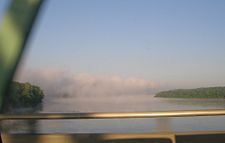
Tourism, services, and wholesale/retail trade follow manufacturing in importance.
Riverboat gambling was approved in 1992. In the 2008 election, voters passed a measure that removed the previous $500 loss limit per person and earmarked the added revenue for funding for elementary and secondary schools. The revision also capped the number of casinos at their present level.
Transportation
The Mississippi River and Missouri River are commercially navigable over their entire lengths in Missouri. The Missouri was channelized through dredging and jetties and the Mississippi was given a series of locks and dams to avoid rocks and deepen the river. St. Louis is a major destination for barge traffic on the Mississippi River.
Demographics
In 2006, Missouri had an estimated population of 5,842,713; an increase of 45,010 (0.8 percent) from the prior year and an increase of 246,030 (4.4 percent) since the year 2000. Over half of Missourians (3,145,584 people, or 56.2 percent) live within the state's two largest metropolitan areas–St. Louis and Kansas City. The state's population density is also closer to the national average than any other state.
The five largest ancestry groups in Missouri are: German (23.5 percent), Irish (12.7 percent), American (10.5 percent), English (9.5 percent), and French (3.5 percent). "American" includes some of those reported as Native American or African American, but also European Americans whose ancestors have lived in the United States for a considerable time.
German Americans are an ancestry group present throughout Missouri. African-Americans are a substantial part of the population in St. Louis, Kansas City, and in the southeastern bootheel and some parts of the Missouri River Valley, where plantation agriculture was once important. Missouri Creoles of French ancestry are concentrated in the Mississippi River Valley south of St. Louis. A substantial number (40,000-50,000) of recent Bosnian immigrants, arriving since 1993, live mostly in the St. Louis area, comprising 12 percent of the city's population.
In 2004, 6.6 percent of the state's population was reported as younger than 5 years old, 25.5 percent younger than 18, and 13.5 percent was 65 or older. More than the national average (81.3 percent) of Missouri residents were high school graduates, and 21.6 percent had a bachelor's degree or higher. Only 3.4 percent of Missourians were foreign-born, and 5.1 percent reported speaking a language other than English at home.
In 2000, there were 2,194,594 households in Missouri, with 2.48 people per household. The homeownership rate was 70.3 percent, and the mean value of an owner-occupied dwelling was $89,900.
Religion
Of those Missourians who identify with a religion, three out of five are Protestants. There is also a moderate-sized Roman Catholic community in some parts of the state; approximately one out of five Missourians are Catholic. Areas with more numerous Catholics include St. Louis and the Missouri Rhineland, particularly south of the Missouri River.[16]
The religious affiliations of the people of Missouri according to the American Religious Identification Survey:[17]
- Christian – 77 percent
- Protestant
- Roman Catholic – 19 percent
- Church of Jesus Christ of Latter-day Saints – 1 percent*
- Other or unspecified Christian – 8 percent
- Other religions – 2 percent
- Not religious – 15 percent
- No answer – 5 percent
Several religious organizations have headquarters in Missouri, including the Lutheran Church—Missouri Synod as well as the United Pentecostal Church International. Kansas City is the headquarters of the Church of the Nazarene. Independence, outside of Kansas City, is the headquarters for the Community of Christ (formerly the Reorganized Church of Jesus Christ of Latter Day Saints), and the Latter Day Saints group Remnant Church of Jesus Christ of Latter Day Saints. This area and other parts of Missouri are also of significant religious and historical importance to the Church of Jesus Christ of Latter-day Saints, which maintains several sites/visitors centers, and whose members make up about one percent of Missouri's population. Springfield is the headquarters of the Assemblies of God and the Baptist Bible Fellowship International. The General Association of General Baptists has its headquarters in Poplar Bluff. The Pentecostal Church of God is headquartered in Joplin.
Education
The Missouri State Board of Education has general authority over all public education in the state of Missouri. It is made up of eight citizens appointed by the governor and confirmed by the Missouri Senate.
Primary and secondary schools
The public schools system includes kindergarten to 12th grade. District territories are often complex in structure. In some cases, elementary, middle and junior high schools of a single district feed into high schools in another district.
Colleges and universities
The University of Missouri System is Missouri's statewide public university system; the flagship institution and largest university in the state is the University of Missouri in Columbia. The others in the system are University of Missouri–Kansas City, University of Missouri–St. Louis, and Missouri University of Science and Technology.
Notable highly rated[18] private institutions include Washington University in St. Louis and Saint Louis University.
Lincoln University in Jefferson City is one of a number of historically black colleges and universities. In 1954, the university began to accept applicants of all races.
There are numerous junior colleges, trade schools, church universities, and private universities in the state.
The state also funds a $2,000, renewable merit-based scholarship, Bright Flight, given to the top 3 percent of Missouri high school graduates who attend an in-state university.
Looking to the future
The population of St. Louis faces the social and economic challenges of most large cities in the United States. For the most part those are loss of jobs to the suburbs, education, transportation, and crime.
However, in the twenty-first century, St. Louis has transformed from a manufacturing and industrial economy into a globally known focus in medical research, biotechnology, and other sciences. The St. Louis region is home to 21 Fortune 1000 companies, nine of which are in the Fortune 500. The region is also home to some of the country's largest privately held corporations, including Enterprise Rent-A-Car and Edward Jones Investment and Financial services, among others.
In 2007, Worldwide ERC and Primary Relocation recognized Kansas City third overall as one of the "Best Cities for Relocating Families" in the United States. Also in March 2007, Money Magazine rated three of Kansas City's suburbs among the top 50 best places. Though these analyses include the entire metropolitan area, they are an important indicator of the realistic situation of life in and around Kansas City.
While the state's large cities are progressive, somewhat cosmopolitan, and hold a large majority of the population, the success of its small towns is highly dependent on geography and transportation. Those located near the cities have grown and prospered by an improved highway system, but many have suffered economic stagnation as the rural population has declined, in many cases relocating to the larger cities.
Notes
- ↑ Error on call to template:cite web: Parameters url and title must be specified.
- ↑ Error on call to template:cite web: Parameters url and title must be specified (CSV). 2011 Population Estimates. United States Census Bureau, Population Division (December 2011).
- ↑ 3.0 3.1 Elevations and Distances in the United States. United States Geological Survey (2001). Retrieved October 24, 2011.
- ↑ 4.0 4.1 Elevation adjusted to North American Vertical Datum of 1988.
- ↑ Michael McCafferty. 2004. Correction: Etymology of Missouri (restricted access). American Speech 79 (1):32
- ↑ American Heritage Dictionary: Missouri Bartleby.com. Retrieved November 20, 2008.
- ↑ Houghton Mifflin Education. US: Midwest Region Retrieved November 20, 2008.
- ↑ David Williamson. June 2, 1999. UNC-CH surveys reveal where the ‘real’ South lies University of North Carolina.
- ↑ Scott House. May 14, 2005. Fact Sheet on 6000 Caves The Missouri Speleological Survey, Inc.
- ↑ D. W. Meinig. 1993. The Shaping of America: A Geographical Perspective on 500 Years of History, Volume 2: Continental America, 1800-1867. (New Haven: Yale University Press. ISBN 0300056583), 437
- ↑ University of Virginia Library. Historical Census Browser, 1860 Federal Census
- ↑ Federation of Tax Administrators. State Tax Excise Rates on Cigarettes - January 1, 2008 Retrieved November 21, 2008.
- ↑ James R. Davis and Ross C. Brownson, "A Policy for Clean Indoor Air in Missouri: History and Lessons Learned," St. Louis University Public Law Review 13(1994): 749
- ↑ Section 191.769, Revised Statues of Missouri
- ↑ Section 290.145, Revised Statutes of Missouri
- ↑ Valparaiso University. Catholics as a Percentage of All Residents, map Retrieved November 21, 2008.
- ↑ City University of New York. 2001 American Religious Identification Survey Retrieved November 21, 2008.
- ↑ U.S. News & World Report. 2008. America's Best Colleges 2009.
ReferencesISBN links support NWE through referral fees
- Blashfield, Jean F. Missouri. New York: Children's Press, 2009. ISBN 9780531185858
- De Voto, Bernard Augustine, and Alfred Jacob Miller. Across the wide Missouri. (1947) reprint ed. Mariner Books, 1998, ISBN 0395924979. (Pulitzer Prize in Literature) and National Book Award.
- Lago, Mary Ellen. Missouri. New York: Children's Press, 2003. ISBN 0516223909
- Lewis, Meriwether, William Clark, and Bernard Augustine De Voto. The journals of Lewis and Clark. Boston: Houghton, Mifflin. (1953) 1997. ISBN 0395859964.
External links
All links retrieved May 31, 2025.
- Missouri's African American History The Missouri State Archives.
- Missouri State Agency Databases
- Missouri Division of Tourism
- Missouri government website
| Political divisions of the United States | |||||||
|---|---|---|---|---|---|---|---|
| |||||||
Credits
New World Encyclopedia writers and editors rewrote and completed the Wikipedia article in accordance with New World Encyclopedia standards. This article abides by terms of the Creative Commons CC-by-sa 3.0 License (CC-by-sa), which may be used and disseminated with proper attribution. Credit is due under the terms of this license that can reference both the New World Encyclopedia contributors and the selfless volunteer contributors of the Wikimedia Foundation. To cite this article click here for a list of acceptable citing formats.The history of earlier contributions by wikipedians is accessible to researchers here:
The history of this article since it was imported to New World Encyclopedia:
Note: Some restrictions may apply to use of individual images which are separately licensed.

